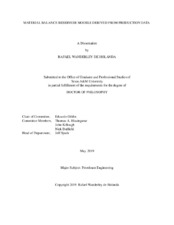| dc.description.abstract | Rate measurements are the most available data gathered throughout the production life of a field, and essential to understand reservoir dynamics. In order to gain knowledge quickly from such data for a massive number of wells, it is important to develop simple reservoir models capable of history matching and predicting performance using rate measurements, but also incorporating other types of data (e.g. bottomhole pressures, well locations, completion status), as available. Even in simplified reservoir models, material balance is a necessary assumption because reservoirs are limited resources of petroleum. In this context, capacitance resistance models (CRM’s) comprise a family of material balance reservoir models that have been applied to primary, secondary and tertiary recovery processes in conventional reservoirs. CRM’s predict well flow rates based solely on previously observed production and injection rates, and producers’ bottomhole pressures (BHP’s); i.e., a geological model and rock/fluid properties are not required. CRM’s can accelerate the learning curve of the geological analysis by providing interwell connectivity maps to corroborate features such as sealing or leaking faults, and high permeability channels. Additionally, oil and water rates are computed by coupling a fractional flow model to CRM’s, which enables, for example, optimization of water allocation in mature fields undergoing waterflooding. In this dissertation, a comprehensive review on CRM’s is presented, summarizing theoretical concepts and relevant aspects for implementation to field data. Additionally, two case studies are presented distinguishing CRM interwell connectivities from streamline allocation factors.
For unconventional reservoirs, the second Jacobi theta function (θ2 model) is a physics-based decline curve model proposed, which can be considered an extension of CRM. It accounts for linear flow and material balance in horizontal multi-stage hydraulically fractured wells. The main characteristics of pressure diffusion in the porous media are embedded in the functional form, such that there is a transition from transient to boundary dominated flow and the EUR is always finite. Analogously to the frequently used Arps hyperbolic, the new model has only three parameters, where two of them define the decline profile and the third one is a multiplier. A case study of 992 gas wells in the Barnett shale is presented with probabilistic forecasts of flowrates and estimated ultimate recovery (EUR) performed in a Bayesian approach. New methodologies are proposed for data treatment, uncertainty calibration, and the design of a localized prior distribution for each well. The results indicate that uncertainty is reliably quantified, and the θ2 model has smaller uncertainty and provides more conservative forecasts than other decline models commonly used (Arps hyperbolic, Duong and stretched exponential models). Additionally, the use of previous production of surrounding wells and geospatial data reduces the uncertainty on the performance of new wells drilled. | en |


